A) contests and sweepstakes to stimulate selective demand.
B) product samples to create secondary demand.
C) advertising to stimulate primary demand.
D) personal endorsements to generate word-of-mouth demand.
E) coupons to maintain brand loyalty or static demand.
G) A) and C)
Correct Answer

verified
Correct Answer
verified
Multiple Choice
Companies can choose from several different branding strategies. Kohl's, with its own Croft & Barrow, SONOMA Goods for Life, and Apt. 9 brands that offer men's and women's apparel and footwear, accessories and home goods in its stores, is using a ________ strategy.
A) retailer branding
B) multiproduct branding
C) multibranding
D) private branding
E) mixed branding
G) B) and C)
Correct Answer

verified
Correct Answer
verified
Multiple Choice
Which of the following products would have a fashion product life cycle curve?
A) skinny ties
B) parabolic skis
C) personal flotation devices
D) razor blades
E) hockey helmets
G) B) and E)
Correct Answer

verified
Correct Answer
verified
Multiple Choice
Skippy, a peanut butter brand like Justin's, both owned by Hormel, is in the ________ stage of the product life cycle, with marketing strategies that include creating PB Bites, finding new consumers through online channels, and positioning the product as a source of protein.
A) introduction
B) growth
C) maturity
D) decline
E) accelerated development
G) C) and E)
Correct Answer

verified
Correct Answer
verified
Multiple Choice
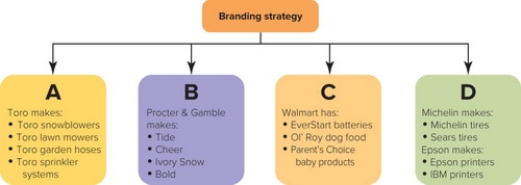 Figure 11-7
-Companies can employ several different branding strategies. In Figure 11-7 above, Box A represents a ________ strategy.
Figure 11-7
-Companies can employ several different branding strategies. In Figure 11-7 above, Box A represents a ________ strategy.
A) retailer branding
B) multiproduct branding
C) multibranding
D) private branding
E) mixed branding
G) A) and C)
Correct Answer

verified
Correct Answer
verified
Multiple Choice
The ________ stage of the product life cycle occurs when a product is launched to its intended target market.
A) concept
B) introduction
C) growth
D) maturity
E) decline
G) B) and C)
Correct Answer

verified
Correct Answer
verified
Multiple Choice
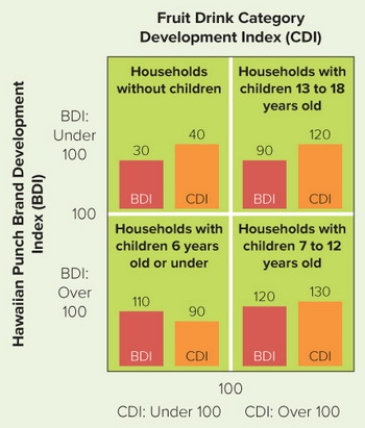 CDI/BDI Marketing Dashboard
-In the CDI/BDI Marketing Dashboard above, which segment consumes the least amount of Hawaiian Punch?
CDI/BDI Marketing Dashboard
-In the CDI/BDI Marketing Dashboard above, which segment consumes the least amount of Hawaiian Punch?
A) households without children
B) households with children 13 to 18 years old
C) households with children 6 years old or under
D) households with children 7 to 12 years old
E) Because the BDI and CDI show inconsistencies in their measurements, especially in the segment of children under the age of six, it is impossible to answer the question.
G) A) and B)
Correct Answer

verified
Correct Answer
verified
Multiple Choice
Brand licensing is
A) the registration fee paid by a manufacturer to states, provinces, or countries in order to sell its products there.
B) a branding strategy in which the producer dictates the brand name to retailers for the products sold to their respective markets.
C) a branding strategy in which a company uses one name for all of its products.
D) a contractual agreement whereby a company allows another firm to use its brand name or trademark with its products or services for a royalty or fee.
E) a branding strategy in which manufacturers produce products but sell them under the brand name of a wholesaler or retailer.
G) A) and C)
Correct Answer

verified
Correct Answer
verified
Multiple Choice
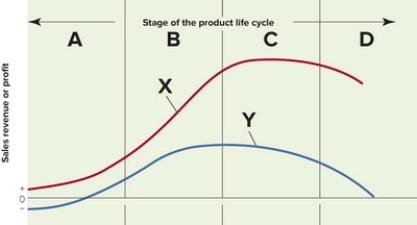 Figure 11-1
-Figure 11-1 above represents the stages of the product life cycle. What does the section of the graph labeled D represent?
Figure 11-1
-Figure 11-1 above represents the stages of the product life cycle. What does the section of the graph labeled D represent?
A) retrenching
B) maturity
C) growth
D) failure
E) decline
G) A) and D)
Correct Answer

verified
Correct Answer
verified
Multiple Choice
As product adopters, innovators
A) have a fear of debt and use neighbors and friends as information sources.
B) are skeptical and have below average social status.
C) are deliberate and use many informal social contacts.
D) are leaders in social settings and have a slightly above average education.
E) are venturesome, higher educated, and use multiple information sources.
G) A) and C)
Correct Answer

verified
Correct Answer
verified
Multiple Choice
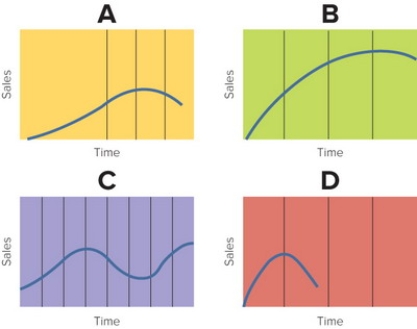 Figure 11-3
-The product life cycle shown in Box A in Figure 11-3 above represents a ________ product.
Figure 11-3
-The product life cycle shown in Box A in Figure 11-3 above represents a ________ product.
A) low-learning
B) fashion
C) fad
D) high-learning
E) generalized
G) All of the above
Correct Answer

verified
Correct Answer
verified
Multiple Choice
Johnson & Johnson effectively repositioned St. Joseph Aspirin from a product for infants to an adult low-strength aspirin to reduce the risk of heart attacks or strokes. This is an example of a product repositioning by
A) reacting to a competitor's position.
B) reaching a new market.
C) catching a rising trend.
D) changing the value offered.
E) product modification.
G) B) and E)
Correct Answer

verified
Correct Answer
verified
Multiple Choice
Directions on how and when to use a product and information about the source and composition of a product that appear on packaging labels provide what kind of benefits?
A) communication benefits
B) storage benefits
C) perceptual benefits
D) protection benefits
E) self-realization benefits
G) A) and B)
Correct Answer

verified
Correct Answer
verified
Multiple Choice
A product manager is sometimes called a
A) chief marketing officer (CMO) .
B) brand manager.
C) marketing manager.
D) category manager.
E) sales manager.
G) A) and E)
Correct Answer

verified
Correct Answer
verified
Multiple Choice
DiGiorno rising crust pizza has been available in the freezer sections of supermarkets for quite a while. The brand's introduction of a DiGiorno cheese-stuffed crust to its line of pizzas is an example of
A) a market-product grid.
B) diversification.
C) market modification.
D) product class extension.
E) product modification.
G) A) and C)
Correct Answer

verified
Correct Answer
verified
Multiple Choice
Desktop PCs are in which stage of their product life cycle according to the text?
A) accelerated downturn
B) cancellation
C) decline
D) maturity
E) devaluation
G) B) and E)
Correct Answer

verified
Correct Answer
verified
Multiple Choice
Managers often use two special measures to help identify strong and weak market segments in order to provide direction for marketing efforts. One of these is the CDI, or
A) category development index.
B) consumer development index.
C) competitive development index.
D) channel development index.
E) customization development index.
G) C) and D)
Correct Answer

verified
Correct Answer
verified
Multiple Choice
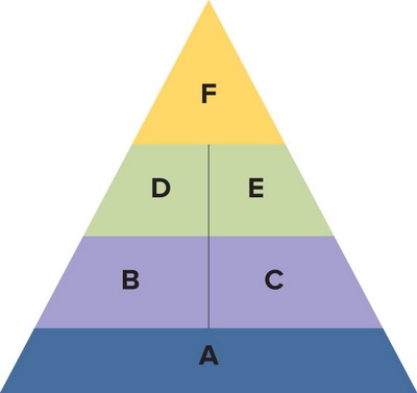 Figure 11-6
-Figure 11-6 above shows the sequential process of building brand equity. Segment A represents the first step, which is to
Figure 11-6
-Figure 11-6 above shows the sequential process of building brand equity. Segment A represents the first step, which is to
A) create a consumer-brand connection.
B) develop positive brand awareness.
C) reward loyal customer behavior.
D) establish a brand's meaning in the minds of consumers.
E) elicit the proper consumer responses to a brand's identity and meaning.
G) B) and E)
Correct Answer

verified
Correct Answer
verified
Multiple Choice
The preference for a specific brand is called ________ demand.
A) selective
B) secondary
C) primary
D) derived
E) explicit
G) A) and C)
Correct Answer

verified
Correct Answer
verified
Multiple Choice
Northland Juices, a division of New York-based Apple & Eve, competes with Ocean Spray in the cranberry juice category. To be successful, Northland must create ________ demand so it will be chosen over competitors.
A) primary
B) derived
C) generic
D) selective
E) secondary
G) A) and D)
Correct Answer

verified
Correct Answer
verified
Showing 281 - 300 of 347
Related Exams